Trends and Leadership Challenges in the Evolution of the Global Economic System
The size and complexity of the world economy has expanded significantly since the 1990s. The United States and European Union economic dominance is today relative rather than absolute. The economic crisis has contributed to accelerate the rebalancing of the distribution of global economic power, and in particular the rise of China as a third pivotal actor. In this paper we focus on trade and financial flows and on the evolution of the monetary system, in order to identify new trends in world leadership. Although the transatlantic relationship is still the main axis of global economic relations, the rise of China indicates future changes in the global order. Therefore, more coordinated action between the transatlantic partners and between them and China could help drive the changes in the world economic system to a more balanced path.
Paper produced within the framework of the IAI project Transworld.
-
Details
Roma, Istituto affari internazionali, 2013, 20 p. -
Issue
9
Introduction
1. The Outlook for the World Economy
1.1 The Evolution of Global Economic Power
1.2 Challenges Ahead
2. The World Economic System: A Fluid Evolution
2.1 Trade: Is "Two" Better Than "Many"?
2.2 Capital Flows
2.3 Monetary Issues: From a Single Currency System to ... What?
3. Emerging Trends and New Leaderships
3.1 "Old" and "New" Leaderships?
3.2 Towards a "Trialogue"?
3.3 A New Theoretical Approach for a World of Uncertainty?
Conclusion
References



